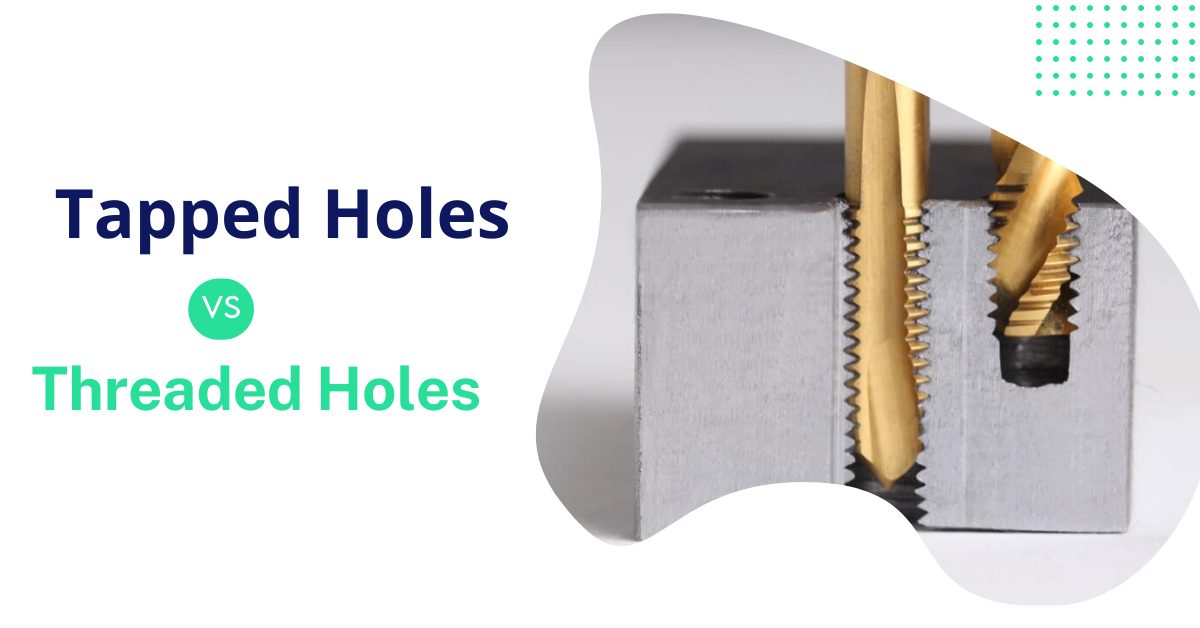There are two common ways to make sure that joints are secure and reliable, which are using tapped holes and threaded holes. Although these terms are often used changeably, they refer to different processes and outcomes. It is important for engineers, machinists, and manufacturers to know the difference between tapped holes and threaded holes as well as their respective applications.
This article will look at definitions, processes, and applications of tapped and threaded holes. It will go into technical aspects, cost considerations, performance comparisons; thus providing a complete guide on how to choose the right type of hole for different industrial needs.
Tapped Holes vs Threaded Holes
Tapped Holes
Tapped holes are used to create tapped holes by cutting internal threads into a pre-drilled hole. This is called tapping and is commonly done when a screw or bolt has to be tightly fastened in metal or other materials. Tapped holes are widely used in automotive, aerospace, and machinery applications because they can provide strong, permanent threads.
Example of Tapped Hole Data
Threaded Holes
On the other hand, a threaded hole is formed by using a threading tool or thread mill. Unlike tapped holes, which are done after drilling. There are different methods of producing a threaded hole, including threading directly into a component or through an existing hole. Threaded holes serve numerous purposes since they can be adapted to several components, such as high-precision parts in electronics and consumer goods.
Example Threaded Hole Data
Differences Between Tapped Holes and Threaded Holes
Process Differences
The processes of creating tapped and threaded holes differ significantly:
-
Tapping Process: Tapped holes are made by drilling a hole and then using a tap to cut internal threads. The various types of taps include cutting taps, forming taps, taper taps and plug taps, which are suitable for different materials and thread sizes.
-
Threading Process: Threading tools or cutting tools are used to create threaded holes. The threading process can be done on both inside and outside threads as needed. Frequently, it takes several passes to achieve the correct depth and pitch of the desired thread.
Structural Differences
Tapped and threaded holes also exhibit structural differences:
-
Internal Threads vs. External Threads: Normally, a tapped hole has internal threads, and threaded holes can also have either external or internal threads, depending on the method applied.
-
Size Hole and Thread Sizes: The size of the hole is important to consider when choosing the corresponding thread size for both tapping and threading. These measurements are often governed by industrial guidelines like Unified Thread Standards or Metric Thread Standards.
-
Blind Hole vs Through Hole:Tapped holes survive as through or blind holes while threaded ones own different types such as through, blind and clearance holes.
-
Clearance Hole and Pilot Hole Definitions: Clearance holes in machining are a little larger than the screw diameter, which makes it easier to put them together. On the other hand, pilot holes are smaller, and they guide a tap or threading tool to make precise threads.
Comparison of Tapped Holes vs Threaded Holes
Performance and Application Comparison
The performance and applications of tapped and threaded holes vary based on several factors:
-
Materials: Hard metals, soft metals, plastics and composites can all have tapped holes and threaded holes. However, the choice of hole type and specific tooling may change based on hardness of the material among others.
-
Speed and Efficiency: Threading is generally faster and more straightforward than tapping particularly with large quantities of components. Even so, threading is more versatile and accurate, making it suitable for high-precision applications.
-
Volume and Batch Production: For mass production purposes, threaded holes may be cheaper because automated machinery as well as threading tools can be utilized. Tapped holes could require more manual labor and time though they are usually simpler to produce.
Cost and Economic Factors
The cost implications of using tapped versus threaded holes can be significant:
-
Setup and Initial Tool Costs: Tapping instruments are normally cheaper and easier to prepare than threading tools and thread mills, which may necessitate particular equipment.
-
Price per unit: The price per unit of tapped holes is normally less compared to that of threaded holes, especially in small scale production. However, when it comes to large-scale production, the automation abilities of threading can help save costs.
-
Maintenance and Tools Life Expectancy: While tapping instruments wear out more quickly, particularly when utilized with hard materials, threading tools, which are expensive, usually have longer tool life and can be sharpened again or replaced easily.
Quality and Reliability
The quality and reliability of tapped and threaded holes are critical considerations:
-
Strength and Durability: Generally, threaded holes have more strength and load bearing capacity than tapped holes, especially when external threads are used.
-
Precision and Accuracy: Ensuring better precision and accuracy, threading is particularly applicable in high-speed tapping centers as well as CNC machines where tight tolerances are required.
-
Potential Issues: Tapped holes tend to suffer from metal shavings and thread wear among others that may affect the durability of the threads themselves.
Technical Aspects of Tapping and Threading
Tapping Process Details
Creating tapped holes involves several key steps and considerations:
-
Pilot Hole Drilling and Preparation: A pilot hole must be drilled before tapping begins; this hole is smaller than the final thread diameter. A tap holder helps guide the tap while creating accurate threads.
-
Tapping Tools and Their Use: In making threads through different materials and requirements for holes, various types of taps like taper taps, plug taps, bottoming taps etc., can be employed.
-
High Speed Tapping Centers and Their Advantages: High speed tapping centers allow quick production of large numbers of tapped holes with greater accuracy.
Threading Process Details
The threading process involves creating threads inside a drilled hole or directly on a component:
-
Creating Threads Inside a Drilled Hole: Threading inside a drilled hole calls for precise control and the use of specialized threading tools or thread mills. This may make several passes necessary to achieve the desired depth of thread.
-
Thread Mill vs Cutting Tap: Thread mills have more flexibility and accuracy than cutting taps especially on CNC machines as they can do various sizes and pitches without changing tools.
-
Threading and Tapping in CNC Machines: In CNC machines, threading and tapping processes are automated hence high precision and accuracy are achieved.
Drill and Tap Size Chart
A tap and drill size chart is a acute device for machinists and engineers since it gives the appropriate drill size for a given tap. The chart makes sure that the pilot hole has the right size for tapping, which stops some problems like thread stripping or incomplete threads.
Metric Tap Drill Sizes
Inch Tap Drill Sizes
Mutual Alternatives for Drilled or Tapped Holes
Additional methods for creating internal threads are:
-
Helical Inserts: Strong threaded provisions can be made in soft or damaged material by using helical inserts and can also be replaced if they get worn out.
-
Thread Rolling: In this method, threads are created by deforming the material, which makes them stronger and more resistant to fatigue.
How to Tap a Hole in Metal?
These are the steps to follow when tapping a hole in metal:
-
Drill the Pilot Hole: Select the right size of the drill from the drill and tap size chart.
-
Lubricate the Tap: Apply cutting fluid so as to minimize friction and tool wear.
-
Align the Tap: Ensure that the tap is aligned with the hole so as to avoid cross-threading.
-
Turn the Tap: Use a tap wrench so that you can turn it, hence cutting into its thread on the hole.
-
Clear the Chips: Occasionally back off from tap so as to clear away any chips of metal thus preventing binding.
Tips to Create Perfect Threaded Holes
-
Use the Correct Tools: The correct taps and threading tools should be used according to the material and thread size.
-
Maintain Proper Alignment: It is necessary to have a perfect alignment of the tap or threading tool with the hole.
-
Control Cutting Speed: Overheating and tool wear can be prevented by using the right cutting speed.
-
Check Thread Quality: Check for thread defects and make sure they meet the required specifications.
Suitable Threaded Hole Diameter
The following factors need to be considered when determining the appropriate diameter for a threaded hole.
-
Material Type: Different materials may require different thread sizes and pitches.
-
Load Requirements: The expected load on the threads will influence the thread size and depth.
-
Industry Standards: Conformance to industry standards guarantees compatibility with screws and bolts.
Cost and Manufacturing
There are economic effects of choosing tapped or threaded holes, which are:
-
Cost-Effectiveness: For small-scale manufacturing, tapped holes are usually more cost-effective, while large-scale or automated production can benefit from using threaded holes.
-
Manufacturing Considerations: Some of these include tooling costs, material wastage, and speed of production.
-
Long-Term Cost Implications: These comprise maintenance, replacement tools, plus possible downtime during the production process.
Pros and Cons of Tapped Hole vs Threaded Hole
Benefits of Tapped Holes
-
Simplicity and Ease of Creation: They are easy to create and require less specialized equipment.
-
Cost-Effectiveness in Small-Scale Production:Tapped holes are cost-effective for small-scale production because the initial costs and tool investment are low.
Advantages of Threaded Holes
-
Versatility and Adaptability: Threaded holes can be used in a wide range of applications and various types of materials.
-
Higher Strength and Load-Bearing Capacity: Especially external threaded holes are especially stronger.
Disadvantages of Tapped Holes
-
Sizes and materials limitations: Not all thread sizes or materials are appropriate for tap holes.
-
Tools that wear out quickly: Tapping tools may wear out fast, particularly when working on hard surfaces.
Disadvantages of Threaded Holes
-
More Complex Process and Equipment Needed: Threaded holes require specialized threading tools and equipment.
-
Higher Initial Setup Cost: The cost of threading tools and equipment can be higher, especially for automated production.
Conclusion
Machining and manufacturing cannot do without tapped and threaded holes in their operations. These two types of holes have different advantages and applications. To understand these differences, we must examine the processes involved, their costs, and how well they perform as a result.











0 Comments